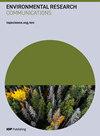Short-term exposure to ambient temperature and the mortality burden of suicide in Japan
IF 2.5
4区 环境科学与生态学
Q3 ENVIRONMENTAL SCIENCES
引用次数: 0
Abstract
Background Previous studies suggest that temperature may trigger suicide, with higher ambient temperatures associated with increased risk globally. However, quantification of the attributable suicide burden due to non-optimal temperatures, particularly across specific subgroups like sex, age, and method of suicide, is limited. This study aimed to quantify this attributable burden across Japan and assess variations in these subgroups to enhance understanding and identify high-risk populations. Methods Data on daily suicide counts and mean temperatures were collected for all 47 prefectures in Japan (1973-2015) for a comprehensive, nationally representative analysis. Using time-stratified case-crossover analyses and a distributed lag non-linear model (DLNM), we estimated temperature-suicide associations, accounting for long-term trends, seasonality, and day-of-the-week effects, and capturing both nonlinear and delayed impacts of temperature. Overall attributable fractions and fractions attributable to cold (0th-10th percentile), cool (10th-50th), warm (50th-90th), and hot (90th-100th) temperatures were computed. Subgroup analyses were conducted by sex, age (0-64 years and ≥65 years), and method of suicide (violent or nonviolent). Results Approximately 19.9% of suicides (95% empirical confidence interval (eCI): 18.8, 20.9) could be attributed to non-optimal temperatures, representing the proportion of cases that would not have occurred under optimal temperature conditions, identified at the temperature corresponding to the minimum risk of suicide. The highest fraction (9.9%, 95% eCI: 9.4, 10.4) was observed for warm temperatures (50th-90th percentile). Higher burdens were observed in females (23.7%), individuals aged ≥65 years (31.9%), and violent suicides (22.4%). Conclusions Nearly 20% of suicides in Japan are associated with non-optimal temperatures, particularly during warmer conditions. These findings highlight the importance of integrating temperature considerations into suicide prevention strategies, particularly for vulnerable populations such as the elderly. While focused on Japan, these results advocate future research to explore similar burdens globally, enhancing our understanding of environmental impacts on suicide and informing targeted public health interventions.短期暴露于环境温度与日本自杀死亡率的关系
背景 以往的研究表明,温度可能引发自杀,在全球范围内,环境温度越高,自杀风险越高。然而,对非最佳温度导致的自杀负担的量化研究还很有限,特别是在性别、年龄和自杀方式等特定亚群中。本研究旨在量化日本各地的可归因自杀负担,并评估这些亚群的差异,以加深了解并识别高危人群。方法 收集了日本所有 47 个都道府县(1973-2015 年)的每日自杀人数和平均气温数据,以进行具有全国代表性的综合分析。利用时间分层病例交叉分析和分布式滞后非线性模型(DLNM),我们估算了气温与自杀的关联,考虑了长期趋势、季节性和周日效应,并捕捉到了气温的非线性和延迟影响。我们计算了总的可归因分数和可归因于低温(第 0-10 百分位数)、凉爽(第 10-50 百分位数)、温暖(第 50-90 百分位数)和炎热(第 90-100 百分位数)温度的分数。按性别、年龄(0-64 岁和≥65 岁)和自杀方式(暴力或非暴力)进行了分组分析。结果 约有 19.9% 的自杀事件(95% 经验可信区间 (eCI):18.8, 20.9)可归因于非最佳温度,这代表了在最佳温度条件下不会发生的自杀事件比例,即在与自杀最低风险相对应的温度条件下确定的自杀事件比例。在温度较高(第50-90百分位数)的情况下,这一比例最高(9.9%,95% eCI:9.4, 10.4)。女性(23.7%)、年龄≥65 岁者(31.9%)和暴力自杀者(22.4%)的自杀率较高。结论 日本近 20% 的自杀事件与气温不适宜有关,尤其是在气温较高的情况下。这些发现凸显了将温度因素纳入自杀预防策略的重要性,尤其是对老年人等弱势群体而言。虽然这些研究结果主要集中在日本,但我们仍建议今后在全球范围内开展类似的研究,以加深我们对环境对自杀的影响的了解,并为有针对性的公共卫生干预措施提供信息。
本文章由计算机程序翻译,如有差异,请以英文原文为准。
求助全文
约1分钟内获得全文
求助全文
文献相关原料
| 公司名称 | 产品信息 | 采购帮参考价格 |
|---|

 求助内容:
求助内容: 应助结果提醒方式:
应助结果提醒方式:


